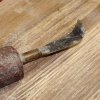Some of these cold days when its too cold in the garage (ie shop), after viewing this nforum, I will surf the web looking of clairification and explinations of some of the things read here. Its amazing what is available.
this
was found which has more information about scrapers than I imagined existed; I wonder how much of it is applicable to the scrapers used in woodturning---Hmmm.
Some of the discussions about food safety came to mind when i saw this statement wood - a naturally anti-bacteria material
(Underdog, feel free to correct the spelling, since I freely admit to being the worlds worst speller)
this
was found which has more information about scrapers than I imagined existed; I wonder how much of it is applicable to the scrapers used in woodturning---Hmmm.
Some of the discussions about food safety came to mind when i saw this statement wood - a naturally anti-bacteria material
(Underdog, feel free to correct the spelling, since I freely admit to being the worlds worst speller)

